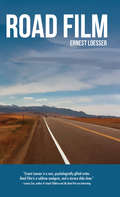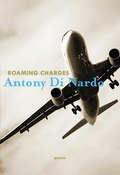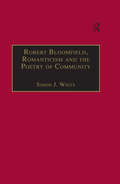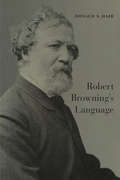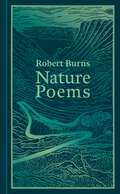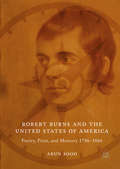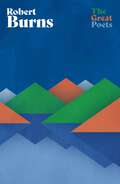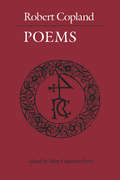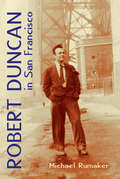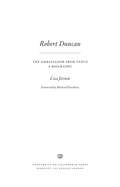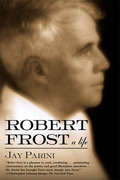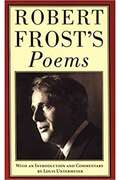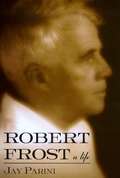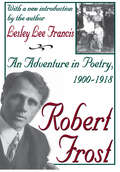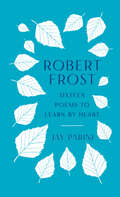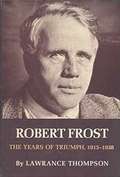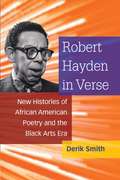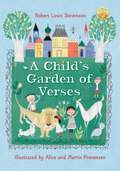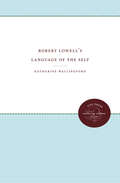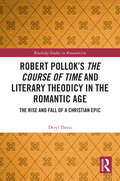- Table View
- List View
Road Film
by Ernest LoesserFramed as a cinematic odyssey, Road Film owes its debt to the famous road movies from the 1960s-80s. Every reader rides shotgun on a trajectory into an American imagination full of joy and angst. Loesser's mix of prose and verse displays the best of the tradition of the New Sentence-and his work as a journalist in New York as a young man, post 9/11. The result reassembles all the broken episodes collected along the lost highways of America: discarded and violent news reports, local and violent rumors, and the unverifiable stories passed from one traveler to the next.Much like his previous work, Touched by Lightning, Loesser uses a reportorial instinct to transfigure the recurrent patterns he finds as a poet in the isolated corners of our homeland. Throughout Road Film, the driver races between two coasts; he jumps from the city into the wilderness-always skirting the moribund American suburbs, and though there be familiar faces, the author's route never leads toward that simple place called home.
Roaming Charges
by Antony Di NardoA turbulent, celebratory flight from an accomplished witness and journeyman. Antony Di Nardo's third collection of poems occupies the air between Canada and Lebanon, viewer and painting, victim and triggerman, reader and page. Blending a bohemian ebullience with a reporter's obligation to witness, the poems in Roaming Charges are a heady and celebratory bouquet of jet fuel, camaraderie and muezzin music. They look long and hard at their subjects, but also speak of the trails those subjects leave across the skies.
Robert Bloomfield, Romanticism and the Poetry of Community (The Nineteenth Century Series)
by Simon J. WhiteRobert Bloomfield, whom John Clare described as 'the most original poet of the age,' was a widely read and critically acclaimed poet throughout the first decade of the nineteenth century, and remained popular until the beginning of the twentieth century. Yet until now, no modern critic has undertaken a full-length study of his poetry and its contexts. Simon J. White considers the relationship between Bloomfield's poetry and that of other Romantic poets. For example, her argues that Wordsworth's poetics of rural life was in some respects a response to Bloomfield's The Farmer's Boy. White considers Bloomfield's emphasis on the importance of local tradition and community in the lives of labouring people. In challenging the idea that the formal and rhetorical innovation of Wordsworth and Coleridge was principally responsible for the emergence of a new kind of poetry at the turn of the eighteenth century, he also shows that it is impossible to understand how the lyric and the literary ballad evolved during the Romantic period without considering Bloomfield's poetry. White's authoritative study demonstrates that, on the contrary, Bloomfield's poetry was pivotal in the development of Romanticism.
Robert Browning's Language
by Donald S. HairWhat are the influences that shaped the language used by one of the nineteenth century's greatest writers? How did his religious beliefs, the books he owned, the paintings and music he loved, affect almost sixty years' output of poems, plays, essays, and letters? This book attempts to define Browning's understanding of the nature and use of words and syntax by considering not only a full range of texts from the 1833 Pauline to the 1889 Asolando, but also the ideas important to Browning, the historical context in which he lived, and the other artistic passions that played a part in his life. In this companion volume to Tennyson's Language, Donald Hair establishes Browning's place at the crossroads between empirical and idealist traditions and explains his "double view" of language, arguing that both Locke and the Congregationalists found language to be at the same time empty and a God-given essential. The Victorian age's anti-theatrical bias, which Browning came to share, and his reading of predecessors, principally Quarles, Bunyan, Donne, and Smart, also shaped his understanding of the diction of poetry. Hair conceives of Browning's language as a theoretical whole, encompassing words, genres, rhyme, syntax, and phonetics. He also links Browning's interest in music with his rhyming, the most essential and characteristic feature of his prosody, and relates his interest in painting to the interpretation of the visual image in the emblem and in typology.
Robert Burns - Nature Poems
by Robert BurnsThis enchanting collection of more than 80 poems captures the essence of the natural world, as seen through the eyes of Scotland's beloved bard. Each chapter explores a different aspect of nature - from wild, mossy mountains and glens to murmuring streams, the sorrowful song of the woodlark, and the ever-changing seasons. Burns's profound appreciation for the landscape of Scotland and its creatures shines through every verse, and this collection is a heartfelt love letter to his homeland. Whether you're a long-time admirer of Burns or discovering his work for the first time, Nature Poems will transport you to the heart of Scotland's natural splendour.Illustrated by local artist, The Ink Bothy, and compiled by Scottish resident and poet Robert Tuesley Anderson, this is a collection to treasure.
Robert Burns - Nature Poems
by Robert BurnsThis enchanting collection of more than 80 poems captures the essence of the natural world, as seen through the eyes of Scotland's beloved bard. Each chapter explores a different aspect of nature - from wild, mossy mountains and glens to murmuring streams, the sorrowful song of the woodlark, and the ever-changing seasons. Burns's profound appreciation for the landscape of Scotland and its creatures shines through every verse, and this collection is a heartfelt love letter to his homeland. Whether you're a long-time admirer of Burns or discovering his work for the first time, Nature Poems will transport you to the heart of Scotland's natural splendour.Illustrated by local artist, The Ink Bothy, and compiled by Scottish resident and poet Robert Tuesley Anderson, this is a collection to treasure.
Robert Burns and the United States of America: Poetry, Print, and Memory 1786–1866
by Arun SoodThis book provides a critical study of the relationship between Robert Burns and the United States of America, c.1786-1866. Though Burns is commonly referred to as Scotland’s “National Poet”, his works were frequently reprinted in New York and Philadelphia; his verse mimicked by an emerging canon of American poets; and his songs appropriated by both abolitionists and Confederate soldiers during the Civil War era. Adopting a transnational, Atlantic Studies perspective that shifts emphasis from Burns as national poet to transnational icon, this book charts the reception, dissemination and cultural memory of Burns and his works in the United States up to 1866.
Robert Burns: A superb collection from Scotland’s finest lyrical poet (The Great Poets)
by Robert Burns'Oh would some power the gift give us, to see ourselves as others see us!' Robert BurnsRobert Burns, poet and lyricist, also known as Rabbie Burns, is widely regarded as the National Poet of Scotland - and much of his work has become part of everyday modern language:'The best laid schemes o' mice and men...''To see her is to love her...'Often credited with writing the lyrics for Auld Lang Syne, he almost single-handedly inspired the movement that preserved Scottish music and lyrics which had been handed down the generations vocally for centuries, thereby maintaining Scots culture and language.A cultural icon and pioneer of the Romantic movement, Burns was chosen as the greatest Scot in a 2009 poll. This collection includes some of his best-loved, most beautiful work.'Now's the day, now's the hour' Robert Burns
Robert Burns: A superb collection from Scotland’s finest lyrical poet (The Great Poets)
by Robert Burns'Oh would some power the gift give us, to see ourselves as others see us!' Robert BurnsRobert Burns, poet and lyricist, also known as Rabbie Burns, is widely regarded as the National Poet of Scotland - and much of his work has become part of everyday modern language:'The best laid schemes o' mice and men...''To see her is to love her...'Often credited with writing the lyrics for Auld Lang Syne, he almost single-handedly inspired the movement that preserved Scottish music and lyrics which had been handed down the generations vocally for centuries, thereby maintaining Scots culture and language.A cultural icon and pioneer of the Romantic movement, Burns was chosen as the greatest Scot in a 2009 poll. This collection includes some of his best-loved, most beautiful work.'Now's the day, now's the hour' Robert Burns
Robert Copland: Poems
by Robert Copland Mary ErlerRobert Copland is (fl. 1505-1546) had a long career as a poet, translator, and printer, and his achievements were substantial. As a printer, he worked for and with Wynkyn de Worde, and his editions look back to the work of Caxton, de Worde's master, and forward, through the work of his successor William Copland, to the Elizabethan period. As a translator, he worked at a time when foreign languages were becoming increasingly necessary to the average Englishman. John Berdan calls Copland one of the main channels of French influence in England during this period. This book makes available the lively poetry of a pre-Renaissance world. In includes lyl of Braintfords Testament, a bequest of farts poem indebted to Chaucer's Summoner's Tale; The Seuen Sorowes That Women Haue When Theyr Husbandes Be Deade, in which conventional misogynist satire moves into psychological complexity; and Copland's most important work, The Hye Way to the Spyttell Hous, an account of vagabond life outside the law in which thieves' cant first sees print. All Copland's work displays a singularly personal quality: as H.R. Plomer says, 'The voice of Robert Copland imparts life to the faint outline that we have of him.' Additional information is contained in the biographical material and notes and glossary. This is a valuable contribution to social history and will be of special interest to those concerned with the early history of English printing.
Robert Duncan in San Francisco
by Michael RumakerA newly expanded edition of an enduring classic, Robert Duncan in San Francisco is both a portrait of the premier poet of the San Francisco Renaissance and a fascinating account of gay life in late 1950s America. Following his graduation from Black Mountain College, Michael Rumaker made his way to the post-Howl, pre-Stonewall gay literary milieu of San Francisco, where he entered the circle of Robert Duncan. His account of that time gives an unvarnished look at Duncan's magnetic personality and occasional failings, while delivering vivid snapshots of other significant poets like Jack Spicer, John Wieners, and Joanne Kyger against the backdrop of legendary North Beach haunts like The Place, Vesuvio, and City Lights Books. Contrasting Duncan's daringly frank homosexuality with his own then-closeted life, Rumaker conjures up with harrowing detail an era of police persecution of a largely clandestine gay community struggling to survive in the otherwise "open city" of San Francisco. First published in 1996, this expanded edition includes a selection of previously unpublished letters between Rumaker and Duncan, and an interview conducted for this edition, in which Rumaker provides further reflections on the poet and the period.Michael Rumaker has written several novels and short story collections, as well as the memoir Black Mountain Days. He was born in Philadelphia, Pennsylvania, and is a graduate of Black Mountain College-where Duncan served as his outside thesis advisor-and Columbia University. He taught at City University of New York and the New School for Social Research.
Robert Duncan, The Ambassador from Venus: A Biography
by Michael Davidson Lisa JarnotThis definitive biography gives a brilliant account of the life and art of Robert Duncan (1919-1988), one of America's great postwar poets. Lisa Jarnot takes us from Duncan's birth in Oakland, California, through his childhood in an eccentrically Theosophist household, to his life in San Francisco as an openly gay man who became an inspirational figure for the many poets and painters who gathered around him. Weaving together quotations from Duncan's notebooks and interviews with those who knew him, Jarnot vividly describes his life on the West Coast and in New York City and his encounters with luminaries such as Henry Miller, Anaïs Nin, Tennessee Williams, James Baldwin, Paul Goodman, Michael McClure, H.D., William Carlos Williams, Denise Levertov, Robert Creeley, and Charles Olson.
Robert F. Murray (Author of the Scarlet Gown): His Poems; with a Memoir
by R. F. MurraySynopsis not available.
Robert Frost
by Jay PariniThis fascinating reassessment of America's most popular and famous poet reveals a more complex and enigmatic man than many readers might expect. Jay Parini spent over twenty years interviewing friends of Robert Frost and working in the poet's archives at Dartmouth, Amherst, and elsewhere to produce this definitive and insightful biography of both the public and private man. While he depicts the various stages of Frost's colorful life, Parini also sensitively explores the poet's psyche, showing how he dealt with adversity, family tragedy, and depression. By taking the reader into the poetry itself, which he reads closely and brilliantly, Parini offers an insightful road map to Frost's remarkable world.
Robert Frost in Context
by Mark RichardsonThis new critical volume offers a fresh, multifaceted assessment of Robert Frost's life and works. Nearly every aspect of the poet's career is treated: his interest in poetics and style; his role as a public figure; his deep fascination with science, psychology, and education; his peculiar and difficult relation to religion; his investments, as thinker and writer, in politics and war; the way he dealt with problems of mental illness that beset his sister and two of his children; and, finally, the complex geo-political contexts that inform some of his best poetry. Contributors include a number of influential scholars of Frost, but also such distinguished poets as Paul Muldoon, Dana Gioia, Mark Scott, and Jay Parini. Essays eschew jargon and employ highly readable prose, offering scholars, students, and general readers of Frost a broadly accessible reference and guide.
Robert Frost's Poems
by Robert Frost Louis UntermeyerA collection of Robert Frost's poems with background information by Louis Untermeyer
Robert Frost's Poems
by Robert Frost Louis UntermeyerA proven bestseller time and time again, Robert Frost's Poems contains all of Robert Frost's best-known poems-and dozens more-in a portable anthology. Here are "Birches," "Mending Wall," "Stopping by Woods on a Snowy Evening," "Two Tramps at Mudtime," "Choose Something Like a Star," and "The Gift Outright," which Frost read at the inauguration of John F. Kennedy." An essential addition to every home library, Robert Frost's Poems is a celebration of the New England countryside, Frost's appreciation of common folk, and his wonderful understanding of the human condition. These classic verses touch our hearts and leave behind a lasting impression.
Robert Frost: A Life
by Jay Parini"I have tried to understand how Frost got from day to day and from poem to poem, tracing his rich, always developing, intellectual and artistic life over many decades. My intention was not to supplant or overtake previous biographers and critics but merely to add a significant layer. I can say without fear of exaggeration that this life of Frost was a labor of love. It is one of the few books I have ever finished with deep reluctance."
Robert Frost: An Adventure in Poetry, 1900-1918
by Lesley Lee FrancisIn this volume, Lesley Lee Francis, granddaughter of Robert Frost, brings to life the Frost family's idyllic early years. Through their own words, we enter the daily lives of Robert, known as RF to his family and friends, his wife, Elinor, and their four children, Lesley, Carol, Irma, and Marjorie. The result is a meticulously researched and beautifully written evocation of a fleeting chapter in the life of a literary family.Taught at home by their father and mother, the Frost children received a remarkable education. Reared on poetry, nurtured on the world of the imagination, and instructed in the art of direct observation, the children produced an exceptional body of writing and artwork in the years between 1905 and 1915. Drawing upon previously unexamined journals, notebooks, letters, and the little magazine entitled The Bouquet produced by the Frost children and their friends, Francis shows how the genius of Frost was enriched by his interactions with his children. Francis depicts her grandfather as a generous, devoted, and playful man with a striking ability to communicate with his children and grandchildren. She traces the family's adventures from their farm years in New Hampshire through their nearly three years in England. This enchanting evocation of the Frost family's life together makes more poignant the unforeseen personal tragedies that would befall its members in later years.
Robert Frost: Sixteen Poems to Learn by Heart
by Robert Frost Jay PariniCelebrate Robert Frost's 150th birthday with a deluxe keepsake edition featuring 16 of his greatest poems—with brilliant essays highlighting his special genius and the power of memorization to unlock the magic of his languageDuring a public reading Robert Frost was once asked why he so frequently recited his poems from memory. With typical wit, he replied: &“If they won&’t stick to me, I won&’t stick to them.&” Remarkably among the modern poets, his poems &“stick&” to the reader: "Mending Wall," with its famous invocation of the rural maxim "Good fences make good neighbors""The Road Not Taken," about the beguiling possibilities of life"Birches," which reminds us that "One could do worse than be a swinger of birches"Stopping by Woods on a Snowy Evening," with its unforgettable final line: "And miles to go before I sleep."Here, poet and Frost biographer Jay Parini presents these and 12 other Frost poems to learn by heart. In short accompanying commentaries, Parini illuminates the stylistic and imaginative features of each of the poems, drawing in biographical material from Frost&’s life to provide further context. &“The goal of this little book is to encourage readers to slow down—to listen to Frost&’s words and phrases, to locate their deepest rhythms, and hear the tune of each poem as it unfolds. . . . Memorizing a poem can teach us much about a poem&’s structure and argument, and about the resonance of particular words. And best of all, memorization makes a poem part of our inner lives. Once committed to memory, a poem is available to us for recall at any time—and the occasions for remembering it will make themselves known to us. It isn&’t something we have to work at.&” Anyone who has read and loved Frost&’s poetry will want to own and treasure this little gift edition. Those reading Frost for the first time or those wishing to become better acquainted with one of America&’s greatest poets will not find a better, more insightful guide than Jay Parini.
Robert Frost: The Years of Triumph 1915-1938
by Lawrance ThompsonRobert Frost: The Years of Triumph, 1915-1938. Volume two of Thompson's Frost biography receives a Pulitzer Prize despite the controversy raised by Thompson's less-than-sympathetic portrait of this American literary giant.
Robert Hayden in Verse: New Histories of African American Poetry and the Black Arts Era
by Derik SmithThis book sheds new light on the work of Robert Hayden (1913–80) in response to changing literary scholarship. While Hayden’s poetry often reflected aspects of the African American experience, he resisted attempts to categorize his poetry in racial terms. This fresh appreciation of Hayden’s work recontextualizes his achievements against the backdrop of the Black Arts Movement and traces his influence on contemporary African American poets. Placing Hayden at the heart of a history of African American poetry and culture spanning the Harlem Renaissance to the Hip-Hop era, the book explains why Hayden is now a canonical figure in 20th-century American literature. In deep readings that focus on Hayden’s religiousness, class consciousness, and historical vision, author Derik Smith inverts earlier scholarly accounts that figure Hayden as an outsider at odds with the militancy of the Black Arts movement. Robert Hayden in Verse offers detailed descriptions of the poet’s vigorous contributions to 1960s discourse about art, modernity, and blackness to show that the poet was, in fact, an earnest participant in Black Arts-era political and aesthetic debates.
Robert Louis Stevenson's A Child's Garden of Verses
by Robert Louis StevensonHow do you like to go up in a swing, Up in the air so blue? Oh, I do think it the pleasantest thing Ever a child can do! Robert Louis Stevenson&’s rhymes have charmed children and adults alike since 1885, when they first appeared to a delighted public. Stevenson&’s joyful exploration of the world speaks directly from a child&’s point of view and celebrates the child&’s imagination. This Golden Books edition, originally published in 1951, features lively, colorful illustrations by Caldecott Medalists Alice and Martin Provensen. The original artwork has been digitally restored for this edition—resulting in a stunning, best-ever reproduction!
Robert Lowell's Language of the Self
by Katharine WallingfordKatharine Wallingford's incisive study treats Robert Lowell's work as a poetry of self-examination and explores the ways in which he used methods common to psychoanalysis and other forms of psychotherapy in his poetry. Although he was never psychoanalyzed in a strictly Freudian sense, Lowell spent many years in psychotherapy. Wallingford stresses not the pathological aspects of Lowell's work, however, but rather his lifelong process of self-examination, a process with ethical as well as psychological dimensions. She links this process to the tradition of self-scrutiny that Lowell inherited from his New England Puritan ancestors.Through close readings of the poetry and of unpublished drafts of several poems as well as letters from Lowell to George Santayana, Allen Tate, and his cousin Harriet Winslow, Wallingford treats Lowell's use of specific psychoanalytic techniques: free association, repetition, concentration on the relation between the poet and the "other" to whom he addresses himself, and the use of memory to probe the past. The book considers as well the role the narrative plays in these psychoanalytic and poetic techniques.Lowell believed firmly in the identity of self and language -- "one life, one writing" -- and this study brings us closer to an understanding both of the poet and of his dense and moving poetry. It enriches our reading of Lowell's poetry by calling attention to the ways in which his poetic techniques are analogous to and to some extent derived from psychoanalytic techniques -- techniques that have in our time become integrated into our culture as a whole.Originally published in 1988.A UNC Press Enduring Edition -- UNC Press Enduring Editions use the latest in digital technology to make available again books from our distinguished backlist that were previously out of print. These editions are published unaltered from the original, and are presented in affordable paperback formats, bringing readers both historical and cultural value.
Robert Pollok’s The Course of Time and Literary Theodicy in the Romantic Age: The Rise and Fall of a Christian Epic (Routledge Studies in Romanticism)
by Deryl DavisThis book explores the contexts and reception history of Robert Pollok’s religious epic The Course of Time (1827), one of the best- selling long poems of the nineteenth century, which has been almost entirely forgotten today. Widely read in the United States and across the British Empire, the poem’s combination of evangelical Calvinism, High Romanticism, and native Scottishness proved irresistible to many readers. This monograph traces the poem’s origins as a defense of Biblical authority, divine providence, and religious orthodoxy (against figures like Byron and Joseph Priestley) and explores the reasons for The Course of Time’s enormous, decades- long popularity and later precipitous decline. A close reading of the poem and an examination of its reception history offers readers important insights into the dynamic relationship between religion and wider culture in the nineteenth century, the uses of literature as a vehicle for theological argument and theodicy, and the important but often overlooked role that religion played in literary— and, particularly, Scottish— Romanticism. This work will appeal to scholars of religious history, literary history, Evangelicalism, Romanticism, Scottish literature, and nineteenth- century culture.
